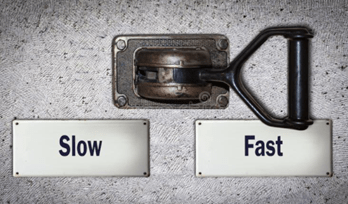Non-Binary Decision Making in Risk

In reality, we know intuitively that decision making operates at various speeds NOT just fast and slow. When we understand learning and the development of heuristics we know that there is plenty that is in between fast and slow in how humans develop decision making. Heuristics and habits are learned gradually over time, there is no sudden switch between fast and slow. Indeed, the language of ‘fast’ and ‘slow’ is unhelpful in safety just as is the idea that human skills as ‘soft’ and ‘hard’. There are no ‘soft’ and ‘hard’ skills, there are only people and non-people skills.
The pejorative language of ‘soft’ and hard’ is unhelpful and that’s why I never use such language in describing communication, humanizing and people-centered skill development.
Kahneman may be a Nobel Prize winning behavioural economist but that doesn’t mean his constructs about human decision making reflect reality. Indeed, Kahneman’s worldview is criticized by many from other disciplines (eg. Kay and King (2020) Radical Uncertainty, Decision Making for an Unknowable Future), not least of which are neuropsychologists and sociolinguists. The language of ‘system 1’ and ‘system 2’ is also unhelpful.
Think about how long it took you to become ‘fast’ at riding a bike. The process takes several years to move from slow to fast.
In SPoR we use a hyphen to represent this semiotically as slow-fast. The hyphen is the key. There is a massive dialectic space between fast and slow when heuristics are developed. This is how all learning works.
Think of the many years it takes in schooling to move from the beginnings of Mathematics and Language to be ‘fast’. The process of embodying knowledge is gradual and it is that gradual period where trial-error exists. We know why safety-risk doesn’t want gradualism in thinking because learning disables brutalism. When your construct is binary zero-not zero, then brutalism is easy. When we recognize people in a process of learning then brutalism isn’t ethical.
We know this from all the research by educators into the most effective approaches to education-learning eg. Robinson Out of Our Minds or Claxton The Wayward Mind or Intelligence in the Flesh. Without a consideration of how the learning of heuristics it is unlikely you will be much help on site if you are a safety advisor. The framing of ‘fast’ and ‘slow’ doesn’t match even the idea of apprenticeship. In Australia, an apprenticeship can take 3-4 years and then once on the job, another 4-10 years to become fast and proficient. Read a bit of Gigerenezer (https://www.researchgate.net/publication/227466812_Simple_Heuristics_That_Make_Us_Smart ) for a start. Gladwell (Outliers) talks about the 10,000 hours it takes for people to become efficient, life is not fast and slow.
It matters what language we use to describe how people make decisions. The way we ‘frame’ a problem often determines our worldview of the problem.
Once we have jettisoned the binary constructs that safety loves we come to people differently. We stop thinking in a binary way and start observing, listening and conversing with people to find out where they are on the learning journey. When we dump binary constructs, we dump zero because zero-one is NOT the sum game.
One of the strange things about zero organisations is that they spend all their time counting the number of times they don’t meet their goal.
What a strange way to define safety and understand risk. What a strange way to frame decision making. What a strange industry that knows so little about learning and education.
When organisations learn to dump zero and binary language they soon learn that none of this rhetoric was ever helpful or practical. This is what we document in the book: It Works, A New Approach to Risk and Safety (https://www.humandymensions.com/product/it-works-a-new-approach-to-risk-and-safety/ ).



Brian says
Rob as always a Great Blog. I would love to see any person who has learnt to drive a car and went from consciously thinking each step to unconsciously carrying out each step. Without doubt one brain three minds makes absolute sense. Things can only change once this fundamental is understood by leaders and those employed in the risk and safety field.
Rob Long says
Yes Brian. Whilst Safety runs around like a chook without a head screaming about 1% safer, zero and endless propaganda and indoctrination, it serves as a wonderful distraction from actually taking seriously the fundamentals of how people make decisions. Sadly, there is little appetite for learning or critical thinking in the industry and lots of energy for policing and brutalism.
Matthew Thorne says
Does Kahneman’s idea of Fast and Slow thinking actually demonise “training” and “learning” as undesirable parts of worklife? Are we negating mentoring through this type of thinking? Promoting the “instant expert”? Or confusing the difference between Intelligence and Wisdom?
Rob Long says
Matt, one of the benefits of a Transdisciplinary approach is to consult across disciplines. Kahneman is no expert on learning that’s for sure neither on linguistics etc. He’s good at selling books with simplistic framing. I think the framing of this book unintentionally devalues learning, dialectic and gradualism. However, its not the message Safety wants to hear. Black and white is far more popular than grey. Similarly any message of wisdom. Why advocate wisdom and understanding when zero will do.